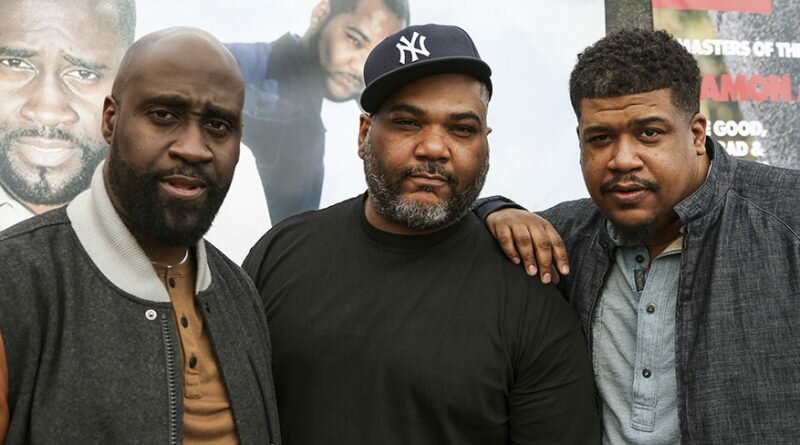De La Soul And Almost Three Decades Of History
You can't talk about hip-hop without mentioning NY trio De La Soul
The story of De La Soul begins in Amityville, Long Island, NY, in the bedroom of group member Mase (Vincent Mason Jr.) where the hip-hop trio first developed its signature surreal style as teenagers. “People have to understand, De La Soul didn’t start out as three solo artists; we’ve always been a group,” explains to the Ebony Magazine the 46-year-old via telephone from his suite at the landmark London Hotel in England, where the group is on a promo tour for its upcoming eighth studio album, And the Anonymous Nobody. “When me, Pos (Kelvin Mercer) and Dave (David Jolicoeur, formerly known as Trugoy) were kids, we were already rhyming and t lying to make songs on a 4-t rack recorder that I had; making music was our dream when we were 12, and its still our dream now.”
First introduced to the world via the trippy single “Plug Tunin’” in 1988, De La Soul is one of the few successful hip- hop groups that never saw a member go solo. “Being in a group can be the ultimate gift and curse,” says Mase. “The gift is when each of us is on the same page, and the curse is getting everybody on the same page.”
The group’s suburban New York sensibilities stood in st ark contrast to the profane gangsta rap of West Coast peers. Instead, this crew was speaking directly to the bookish, socially conscious kids on the block, finding like minds (and sounds) via the Native Tongues, the hip-hop collective that included the likes of the Jungle Brothers, A Tribe Called Quest, Queen Latifa and Monie love.
“De La and the Native Tongues helped inspire a generation of Black kids to be themselves.” says music critic Mensah Demary. “It seems like a small thing at first glance, but it is invaluable to know it’s OK to be yourself, to like what you like and to have all these things shine through in one’s art.” In the spring of 1989, the same year George H.W. Bush was inaugurated, De La Soul released its debut album, 3 Feet High and Rising. Produced by Prince Paul, a friend of Mase’s and a member of hip-hop band Stetsasonic, it became an instant classic. Twenty-one years after its release, it was selected by the Library of Congress to be placed on the National Recording Registry.
“I’d met Paul when he and Stet were working on their second tracks that didn’t make the final album,” Mase says. “It was so different, I knew that Paul would get the stuff we were working on, because his stuff was right in line with ours.”
Although Prince Paul provided the sample-heavy sounds, which later led to an industry rocking lawsuit in 1991, it was his Stetsasonic co-founder Daddy-O who gave the group’s demo to Tommy Boy Records President Monica Lynch. The home of a diverse roster that included Soul Sonic Force (“Looking for the Perfect Beat”) and Force MD’s (“Love Isa Mouse”), Tommy Boy was still a small label, but it was also willing to take a chance on the unconventional crew.
#tbt #delasoul #1993 pic.twitter.com/TbzO3zKJTT
— De La Soul (@WeAreDeLaSoul) November 17, 2016
“De La Soul was on [its] own trip, and I loved it,” Lynch recalls. “When I met them, they were quiet guys with a pretty wild look; they had just graduated from of high school. Their difference was reflected in their art. The two songs on the demo were ‘Plug Tunin’ which was so raw and abstract , and ‘Freedom of Speak.’ Then there were the skits they created for 3 Feet High; that was another layer of weirdness, comedy and mystery. Whatever they did, De La Soul struck a chord with people.”
While competing labels First Priority and Profile also expressed interest, the group members were determined to sign with a label that respected them as artists. Pos, 47, explains: “We just felt that Tommy Boy and Monica Lynch had a genuine interest that made us feel good; her energy was electric. I don’t think any other label would’ve just let us be who we were. Monica allowed us to do what we needed to do, then figured what to do with it [marketing, radio, videos] later.”
Veteran hip-hop journalist and actor Bonz Malone, who first published a feature on the trio for Spin magazine in 1989 (calling the group “a suburban rap crew… with a beat closer to Billy Joel than James Brown”), says “3 Feet High was just a masterful work that was so funky. That summer, it was possible to walk clown the block without hearing ‘Potholes in My Lawn’ or ‘Me, Myself and I.’ De La was the start of a different era in hip-hop.”
Despite the alt-rap appeal, the group still earned stripes as true ’80s b-boys who hung-out and performed at famed Manhattan venues such as The World, Latin Quarter and Hotel Amazon. “That was such a great amazing time for New York hip-hop,” Pos recalls. ‘‘1 learned so much watching shows in those clubs, it was like being in school. Watching KRS-One perform with Scott La Rock or meeting Guru and DJ Premier at the bar was a lot of fun, but you don’t realize the fun you’re having will later inspire you to make a beat, write a rhyme or both.”
Pos, Dave and Mase approached Asia Minor on the dance floor at Hotel Amazon in 1988 and asked if she wanted to perform on tour with them. “At first I said no,” says the now- 42-year-old actress and graphic artist, “but a year later I became a backup dancer. The label had been worried that their live show was kind of boring, but when they hired me and another dancer, they had us on stage doing skits, riding tricycles and roller-skating. I was 16 years old, but these guys were taking me around the world. We were like a tight- knit family that looked out for each other. They were like my three big uncles.”
Having grown tired of being called “hip-hop hippies,” the group’s second album, De La Soul Is Dead (1992), was less psychedelic and more real-world, taking on weighty subjects such as drug addiction (“My Brother’s a Basehead”), child abuse (“Millie Pulled a Pistol on Santa”) and gangster rap (“Afro Connections at a Hi-5 (In the Eyes of the Hoodlum”). “They were always thoughtful and intellectual with how they approached their music,” says Minor. It was also during this time that she introduced teenager Yasiin Bey, then known as Mos Def, to the group. “Mos started showing up at almost every session, and he just had this great young spirit and energy,” Pos says. “Listening to him made me come together more as a lyricist.”
In 1996, when the group recorded its fourth album, Stakes Is High, Mos appeared on “Big Brother Beat,” the track that helped put him on the lyrical map: “This is the mighty Mos Def Style fresh like baby breath,” the young Brooklyn rapper boasted. Stakes Is High also featured appearances by Common and producer Jay Dilla. Another noteworthy collaboration would come in 2000 when the group tapped the legendary Chaka Khan for “All Good” on its fifth album, Art Official Intelligence: Mosaic Thump.
“To meet Chaka, for her to come to the studio to work with us was an honor. It was beautiful, but it was also very intimidating. Even when she asked, ‘Is it all right? Do you think I could do it better?’ I’m thinking, ‘You’re Chaka Khan; everything you do is great.”’
In 2015, De La Soul launched a successful Kickstarter campaign to fund And the Anonymous Nobody, and went on to raise more than $600k from 11,169 backers — nearly five times the original goal. The fundraiser allowed the group to spend over a year in L. As The Vox studio with its backing band, the Rhythm Roots Allstars, and producer Supa Dave West.
Top 30 Hip Hop Albums Of 2016
#13. De La Soul – And The Anonymous Nobodyhttps://t.co/7chgAlw2P5 pic.twitter.com/XTYQZ3xz13
— Hip Hop Golden Age (@HipHopGoldenAge) January 1, 2017
“Originally, we were going to make a conventional De La album with samples called You’re Welcome, but we later decided we wanted to try something different and work with a band,” Pos says. “This album challenged us in ways other projects haven’t; all the music came from jam sessions. It was a really dope experience, and it gave me a real understanding of how artists like the Ohio Players and James Brown worked: They jammed until they had enough material for a record.”
The trio collaborated with a diverse group of musicians for the album, including Usher (“Greyhounds”), 2Chainz (“Whoodeeni”), David Byrne (“Snoopies”) and Little Dragon (“Drawn”), and Snoop Dogg appears on the lead single, “Pain.” The album’s title was suggested by Dave, who uses the name Anonymous Nobody on checks when donating money to charity. “De La Soul arc very much innovators all the time. Even their conversations in the studio are creative,” says Supa Dave. “They are always coming up with new concepts and throwing colors on the canvas. They take a lot of chances and they’re also very funny, which also comes across in their work.”
Nearly 30 years after 3 Feet High and Rising, the crew known as De La Soul is here to prove that longevity in hip-hop is possible – as long as artists can learn to stay connected. “We can argue, disagree or fight, but in the end, we will always be family,” Pos concludes. “Being in a group is hard, but with De La Soul, we still respect one another. Whatever might happen, we have each other’s back.’’






